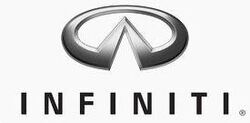 | |
| Type | Division |
|---|---|
| Founded | 1989 |
| Headquarters | Tokyo, Japan |
| Key people | Toru Saito, Corporate Vice President of Infiniti |
| Industry | Automotive |
| Products | Automobiles |
| Parent | Nissan Motors |
| Website |
Infiniti USA Infiniti Coches Espana Infiniti Italy Infiniti Canada Infiniti Europe Infiniti of Britain Infiniti Middle East |
Infiniti (Japanese: インフィニティ Infiniti) is the luxury division of automaker Nissan and vicariously, Renault through the Renault-Nissan Alliance. Infiniti officially started selling vehicles on November 8, 1989 in North America. Marketing operations have since grown to include the Middle East, South Korea, Russia, Taiwan, China, and Ukraine. Infiniti began sales in additional European markets in late 2008. The marketing network for Infiniti-branded vehicles now includes over 230 dealers in over 15 countries.[1]
The marque is not used in Japan and the automaker markets most of equivalent Infiniti models domestically as Nissans: Infiniti G as the Nissan Skyline sedan and coupe, Infiniti M as the Nissan Fuga, Infiniti EX as the Nissan Skyline crossover, and Infiniti Q45 as the Nissan Cima. The Infiniti FX has no Nissan equivalent and is not sold in Japan. The first generation Infiniti Q45 was sold as the Nissan Infiniti Q45 in Japan.
History[]
1989: The beginning[]

1990-1993 Infiniti Q45
The Infiniti brand was introduced in the United States in 1989. The marketing strategy was to target the premium vehicle segments in the United States that would not have otherwise fit in with Nissan's more mainstream image. The brand was created around the same time as Japanese rivals Toyota and Honda's developed their Lexus and Acura premium brands. The Japanese government imposed Voluntary Export Restraints for the U.S. market, so it was more profitable for automakers to export more expensive cars to the U.S.
The Infiniti marque was launched with the Q45 that was based on the all new second generation JDM Nissan President on a 5 milimeter shorter wheelbase platform at 2,875mm (113.2 in). Starting with model year 1992, the wheel base matched the Presidents wheelbase at 2880mm (113.4 in ). The Q45 included a 278 hp (207 kW/282 PS) V8 engine, four wheel steering, and active suspension system offered on the first generation Q45t. The car's features would have made it competitive in the full-sized "luxury" segment against the Mercedes S-Class, BMW 7 Series, Jaguar XJ, and Cadillac Fleetwood; however, the Q45s appearance was less conventional in comparison to the Toyota rival, the Lexus LS. Infiniti also didn't offer a executive class sized sedan to match the first Japanese luxury sedan introduced to North America, the Acura Legend until the introduction of the Infiniti J30, which also contended with the newly revised 1992 Lexus ES. There were market-driven requests for Nissan to introduce the very successful Nissan Skyline, Nissan Laurel, or the newly created Nissan Cefiro as an alternative to the Lexus ES or the Legend, but Nissan hesitated until 2003 when the Skyline finally arrived in North America as the Infiniti G.
1990s[]

1990 Infiniti M30

1992 Infiniti J30
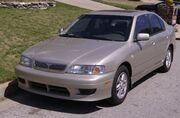
2002 Infiniti G20
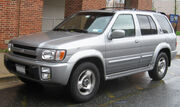
1997-2000 Infiniti QX4
A second model was introduced in 1990, the 2-door M30, a badge engineered Nissan Leopard. It remained in production for three years as an alternative to the Lexus SC. The powertrain was the VG30E 162 hp (121 kW/164 PS) engine and an automatic transmission. The M30 coupe was underpowered for its stock weight of 3,333 lb (1,512 kg). The M30 convertible weighed even more, due to the required body and chassis reinforcements. The appearance of the M30 had almost no resemblance to the larger Q45, and the interior was completely different, other than a round analog clock.
In 1991, Infiniti introduced a third model, the Infiniti G20, based on the Nissan Primera, essentially an upgraded version of the Nissan Sunny with a leather interior package and the SR20DE DOHC 150 bhp (112 kW/152 PS) engine with multi-port fuel injection for improved performance.
For the 1993 model year, Infiniti introduced a four-door coupé J30 with only one engine option, the 210 hp (157 kW/213 PS) VG30DE. This engine was borrowed from the 222 hp (166 kW/225 PS)300ZX, the JDM Nissan Cedric, Nissan Gloria and the Nissan Cima, and was the North American version of the third generation JDM Nissan Leopard.
Infiniti sales were slow. The company's initial campaign aimed to bring about brand awareness with Zen-influenced spots that focused on nature and tranquility. However, the ads did not show the actual cars. Designers decided not to adorn the interiors with wood accents and chrome brightwork, opting for a monochrome appearance focusing on padded leather and vinyl throughout the vehicles. Some buyers had faux wood appliques added to areas surrounding the center console and around the interior door handles. The only item that had a bright appearance was the centrally installed analog clock in all models, a design that is maintained by the designers.
By the mid-1990s, Infiniti was lagging behind Lexus and Acura in sales. The Q45 had retreated considerably from its focused, taut rendition of a sporty executive sedan, having become a barely recognizable, ponderously handling sedan that earned the nickname "The Japanese Lincoln"[citation needed]. In 1999, Infiniti revived the G20, based on the discontinued JDM Nissan Primera, a compact sport sedan whose production was halted for 1998 in Europe and Japan. The second generation G20 was marketed as a competitor to European entry level luxury sport sedans, but it now weighed more than the first generation version. Because Infiniti continued to use the SR20DE four cylinder engine and compact size[citation needed], it fell short of sales expectations. The G20 was also marketed primarily to the wrong demographic, that being middle-aged professional women[citation needed], and as such was not as popular new as its actual main competition, the similarly priced Acura Integra.
In 1997, Infiniti released the QX4, modifying and adding premium accommodations to the Nissan Pathfinder, rather than the larger Nissan Safari. This made Infiniti one of the first makers (apart from SUV specialists, Jeep and Land Rover) to offer a mid-sized luxury-type SUV - predating the release of the Lexus RX 300, Acura MDX and the Mercedes-Benz ML320. The QX4 was released after Acura's introduction of the larger SLX (a rebadged Isuzu Trooper) and the Lexus LX (a rebadged Toyota Land Cruiser). Like a traditional SUV, it was based on a truck platform giving it a competitive edge for its off-roading abilities.
Infiniti replaced the J30 mid-sized rear drive sedan with the second generation JDM Nissan Cefiro giving it the North American designation I30 in 1996, but as with the J30, and M30, continued to offer only one under-powered engine[citation needed], the 193 PS (142 kW/190 hp) VQ30DE with front wheel drive shared with the Maxima. Infiniti made major changes to the I30 in terms of appearance and performance in 2002, upgrading the engine to the more powerful 231 PS (170 kW/228 hp) VQ35DE which incurred a name change to the vehicle, calling it the I35. Sales and the brand, bereft of an image or a following, floundered.
2000s[]

2002-2004 Infiniti I35
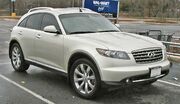
2006 Infiniti FX

2008 Infiniti G37 Sport
By 2000, Infiniti was facing extinction. The company rededicated itself to developing a dynamic and powerful line-up of sporty luxury cars. Car and Driver reported that Infiniti executives invited members of the motoring press to a meeting where they "swore never again to take their eyes off BMW."[citation needed] Although this effort began with a completely redesigned Q45 flagship for the 2002 model year, it was the G35 that helped sales improve for Infiniti in 2003. In Japan, Nissan had a well established reputation with premium level performance sedans after Nissan acquired the Prince Motor Company and integrated the Nissan Skyline, Nissan Laurel, and Nissan Gloria, originally Prince vehicles, in 1966-1968. A sports sedan replacing of its Nissan Primera-based predecessor (the G20), the Nissan Skyline-based G35 was successful after it was selected Motor Trend Car of the Year in 2003.
The release of the sport-tuned FX35/45 crossover that same year piggybacked on the G35's success. The FX used the same components as the G35 sport coupe and was designed for American tastes. It combined good handling and performance with station wagon-like versatility and all-weather capability. In 2004, Infiniti added an all-wheel drive version of the G35 sports sedan to compete with similar all-wheel drive sports sedans from Audi and BMW. Infiniti also introduced a larger SUV to compete with the Toyota Land Cruiser/Lexus LX470. This was the 2004 Infiniti QX56 based on the U.S. market Nissan Armada.
Nissan Motors President and CEO, Carlos Ghosn, developed a business strategy to break Infiniti away from its Nissan roots. The G35 series helped re-define Infiniti as the "Japanese BMW,"[citation needed]. The M35/M45 garnered acclaim from the automotive press, winning an eight-car comparison test in Car and Driver, and the model named the best luxury sedan by Consumer Reports.[citation needed] The M45 model featured the same engine as the Q45, and the M45 became the flagship model after the Q45 was withdrawn from the lineup. The Infiniti M (2003–2005) and the Infiniti G (starting in 2003) were known in Japan as the Nissan Gloria and the Nissan Skyline.
For the 2007 model year a redesigned version of the G35 sedan was introduced, followed in 2008 by a new version of the company's G coupe, the G37. The coupe was first unveiled at the New York International Auto Show. Also released in 2008 is the new Infiniti EX35 compact crossover, which is Infiniti's entry into the compact luxury crossover market. The EX shares the G35's 3.5 liter, 306 hp (228 kW), V6 engine.
Carlos Ghosn unveiled Infiniti’s arrival in Europe at the Geneva Motor Show 2008.[2] The official launch was late-2008, and was phased over a two year period across 21 European countries. Four models are offered in Europe: the next generation of the Infiniti FX37 and Infiniti FX50 performance SUV, the Infiniti G37, the Infiniti G37 coupe, and the Infiniti EX37 crossover. Infiniti Europe’s headquarters are based in Rolle, Switzerland.[3]
2010s[]

Infiniti M56
Carlos Ghosn unveiled the Infiniti M at a hotel in Los Angeles. It shares the VQ37VHR from the Infiniti G, Infiniti EX, and Infiniti FX. Featured are new powertrains: the 5.6 L V8 (VK56VD) with VVEL, Gasoline direct injection, the Nissan-Renault V9X Engine V6 Turbo Diesel (only for Europe), and the newly developed hybrid that will include one electric motor and two clutches to allow the gas engine and electric motor to drive the rear wheels simultaneously. The lithium-ion battery pack will come from the Infiniti Essence.
At the 2010 Geneva Motor Show, Infiniti launched a new powertrain for Europe, with the new V9X Engine engine developed by the Nissan-Renault alliance group. The new engine is used in the Infiniti FX, Infiniti EX, and the new Infiniti M. The new Infiniti M made its European debut at the show.
In August 2010 Infiniti unveiled its new performance division named Infiniti Performance Line, or IPL.[4]
In 2011, Infiniti chose to sponsor the Renault engines for Red Bull Racing for the 2011 Formula One season. [5]
United States sales by calendar year[]
| Year | U.S. sales |
|---|---|
| 2002 | 87,911 |
| 2003 | 118,655 |
| 2004 | 130,980 |
| 2005 | 136,401 |
| 2006 | 121,416 |
| 2007 | 127,038 |
| 2008 | 112,989 |
| 2009 | 81,089 |
| 2010 | 103,411 |
Models[]
Infiniti's model name designation includes one letter for coupés and sedans (two letters for SUVs) and a number reflecting engine displacement. For example, the QX56 is an SUV featuring a 5.6 L engine. An exception to this was the QX4 SUV, which featured a 3.3 L engine (1997–2000) and later a 3.5 L engine (2001–2003). An "x" following the engine displacement of Infiniti sedans denotes an all wheel drive model (e.g. Infiniti G35x), "s" denotes a sport package, "h" denotes a hybrid model, and a "t" for a Touring model (older models only).
Current[]
All current Infiniti coupes, sedans and crossovers are based on the Nissan FM platform. The center of the engine is placed behind the front wheels. This placement evens the weight distribution to improve braking, acceleration, and handling. It also reduces the polar moment of inertia[citation needed]. The exception is the QX56 full-size SUV that rides on the Nissan F-Alpha platform.
- Infiniti G (convertible 3.7L, coupe 3.7L, AWD coupe 3.7L, sedan 2.5L & 3.7L & AWD sedan 2.5L & 3.7L, IPL)
- Infiniti M (M35h,M37/M37x AWD and M56/M56x AWD variations, all sedans)
- Infiniti EX (EX37 in Europe)
- Infiniti FX (FX35, FX37 and FX50 variations)
- Infiniti JX - to be introduced in 2012
- Infiniti QX56 (SUV)
Past[]
- Infiniti G20 (sedan)
- Infiniti G35 (coupe and sedan)
- Infiniti M30 (coupe and convertible)
- Infiniti M35 (sedan)
- Infiniti M45 (sedan)
- Infiniti QX4 (SUV)
Discontinued[]
- Infiniti J30 (sedan)
- Infiniti I (I30, 1996–2001; I35, 2002–2004, all sedans)
- Infiniti Q45 (sedan)
Concept vehicles[]
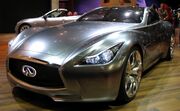
Infiniti Essence
- Infiniti Kuraza (Concept vehicle, no current plans for production)
- Infiniti Essence (Concept vehicle, no current plans for production)
Future vehicles[]
- Hybrid version of the M sedan[6]
- Diesel versions of the M sedan, EX and FX were unveiled at the 2010 Geneva Motor Show.(Europe only)
Infiniti Performance Line[]
In August 2010, Infiniti unveiled its new performance division named Infiniti Performance Line, or IPL.[7]
Motorsports[]

Infiniti Indy car next to a production Q45
In 1996, Nissan launched an effort to compete in the Indy Racing League with the Infiniti brand.[8] The engine chosen for the Indy cars was a race variant of the VH engine used the Q45s. The IRL program was quietly wrapped after the 2002 season after only a few wins.[9] The Renault engines powering the Red Bull Racing 2011 F1 challenger was expected to be rebranded as an Infiniti engine but, the sponsorship deal did not extend to engine re-brading.[10]
References[]
| This page uses some content from Wikipedia. The original article was at Infiniti. The list of authors can be seen in the page history. As with Tractor & Construction Plant Wiki, the text of Wikipedia is available under the Creative Commons by Attribution License and/or GNU Free Documentation License. Please check page history for when the original article was copied to Wikia |
- ↑ http://www.infiniti.com/global/en/about/brand-history#/about/brand-history
- ↑ Madslien, Jorn (6 March 2008). "Nissan launches luxury brand in Europe", BBC News. Retrieved on 15 August 2010.
- ↑ Fontanelle, Anthony (26 March 2008). "Infiniti Parks In Rolle". www.amazines.com. Retrieved on 15 August 2010.
- ↑ Migliore, Greg (14 August 2010). "IPL: Why Infiniti is Now Aiming for Performance". autoweek.com. Crain Communications. Retrieved on 15 August 2010.
- ↑ "Red Bull boosted by Infiniti deal", BBC News (1 March 2011).
- ↑ Speer, Lawrence J. (4 March 2009). "Infiniti to launch gasoline hybrid". Automotive News Europe. Retrieved on 15 August 2010.
- ↑ Migliore, Greg (14 August 2010). "IPL: Why Infiniti is Now Aiming for Performance". autoweek.com. Crain Communications. Retrieved on 15 August 2010.
- ↑ Oldham, Scott (August 1996), "Asia Spy Report", Popular Mechanics. 8 173: 27, http://books.google.com/books?id=Q2YEAAAAMBAJ&pg=PA26&lpg=PA26&dq=Nissan+discontinue+providing+engines+to+the+Indy+Racing+League&source=bl&ots=MOhOYRI2Yw&sig=TXH5DA5Xo0J9Ap_Puq0B3s3zRYI&hl=en&ei=_VhoTMqzOYOglAfunpGfBQ&sa=X&oi=book_result&ct=result&resnum=9&ved=0CEEQ6AEwCA#v=onepage&q&f=false. Retrieved on .
- ↑ RainMeister (14 June 2002). "IRL: Nissan Withdraws". freshalloy com. Retrieved on 27 August 2010.
- ↑ "Red Bull to Use Infiniti branded Engines". Pitpass.com. Retrieved on 28/2/2011.
External links[]
Media related to Infiniti vehicles at Wikimedia Commons
- Infiniti.com - Official Infiniti Global site
- InfinitiUSA.com - Official Infiniti USA site
- Nissan Motor Corporation
- Infinitihelp.com - Unofficial Infiniti site. Bulletins, Manuals, and Recalls
- Infiniti Espana - The Spanish Infiniti Site
- Infiniti Italia - The Italian Infiniti Site
| Infiniti, a division of Nissan Motor Co., Ltd., road car timeline, 1990–present | ||||||||||||||||||||||
|---|---|---|---|---|---|---|---|---|---|---|---|---|---|---|---|---|---|---|---|---|---|---|
| Type | 1990s | 2000s | 2010s | |||||||||||||||||||
| 0 | 1 | 2 | 3 | 4 | 5 | 6 | 7 | 8 | 9 | 0 | 1 | 2 | 3 | 4 | 5 | 6 | 7 | 8 | 9 | 0 | 1 | |
| Coupe | M30 | G35C | G37C | |||||||||||||||||||
| Entry-level | G20 | G20 | G35 | G25/G35/G37 | ||||||||||||||||||
| Mid-size | I30 | I30 / I35 | ||||||||||||||||||||
| J30 | M45 | M35 / M45 | M37 / M56 | |||||||||||||||||||
| Full-size | Q45 | Q45 | Q45 | |||||||||||||||||||
| SUV | EX35 / EX37 | |||||||||||||||||||||
| FX35 / FX45 | FX35 / FX50 | |||||||||||||||||||||
| QX4 | QX56 | QX56 | ||||||||||||||||||||
| ||||||||||||||||||||||||||||||||||||||||||
| |||||